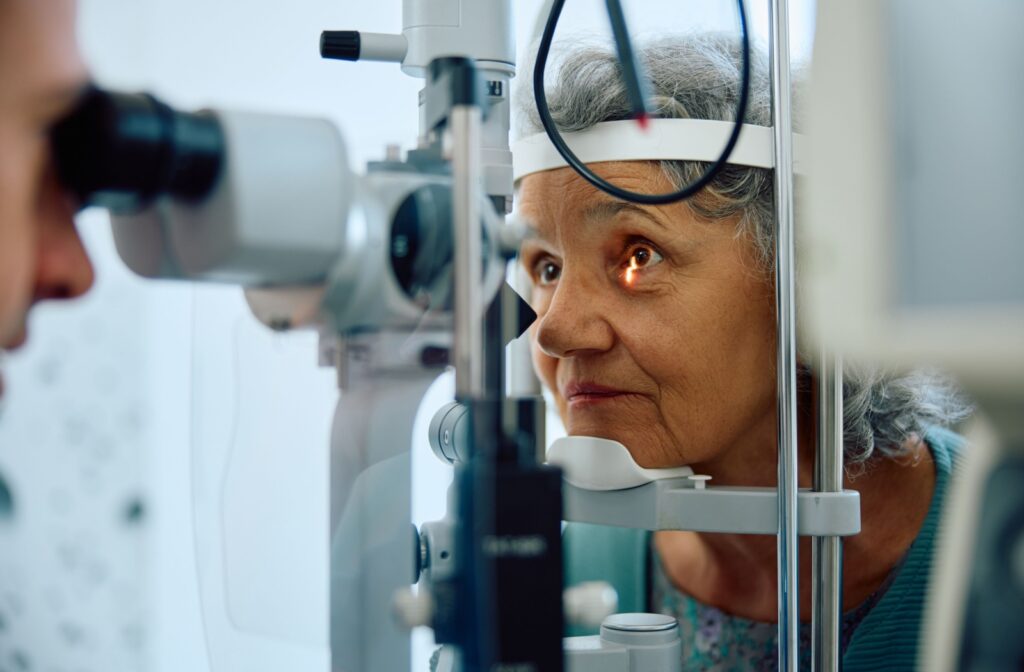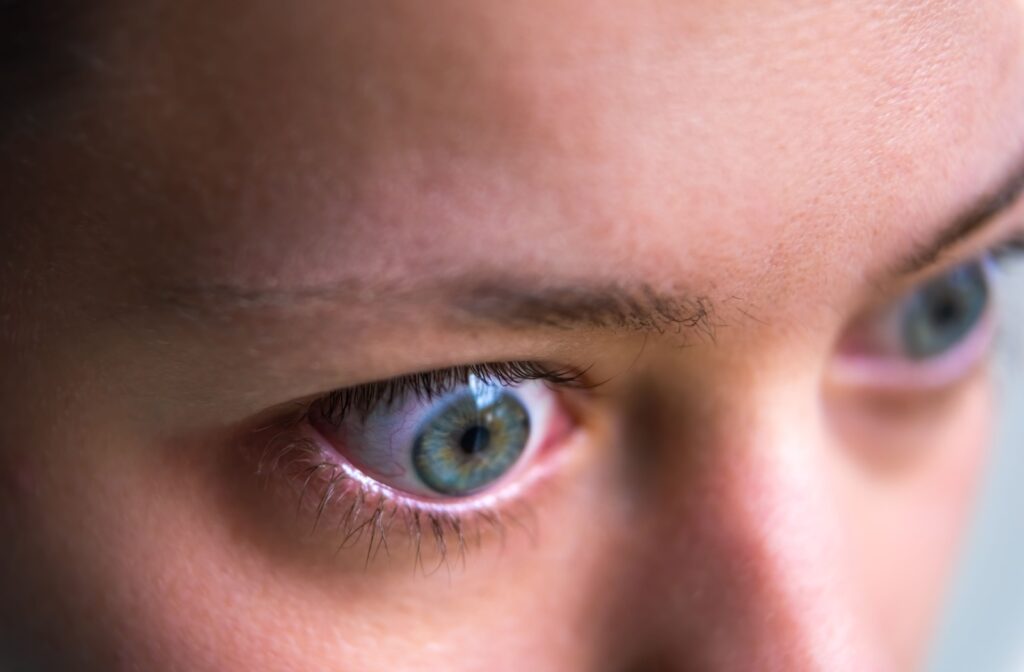Graves’ eye disease, or thyroid eye disease (TED), is a lesser-known autoimmune condition that can significantly impact eye health by causing swelling around the eyes, which causes them to bulge. While symptoms of Graves’ eye disease can feel unsettling, they typically only last one to two years and go away on their own. An optometrist can help diagnose Graves’ eye disease with an examination and then help manage the condition to ease daily symptoms.
Whether you’re experiencing thyroid issues or simply seeking answers for puzzling eye symptoms, gaining clarity and awareness is essential to managing your health.
What Is Graves’ Disease?
Graves’ disease is an autoimmune disorder that affects the thyroid gland, a small but mighty gland in the neck. The immune system mistakenly attacks the thyroid, causing it to produce excessive thyroid hormones. This overproduction results in hyperthyroidism, a condition characterized by an “overactive” metabolism. Common symptoms of Graves’ disease include weight loss, rapid heart rate, anxiety, heat sensitivity, and fatigue.
Graves’ disease can also affect other parts of the body, including the eyes, which is where Graves’ eye disease comes into play.
What Is Graves’ Eye Disease?
Graves’ eye disease, or thyroid eye disease (TED), occurs when the immune system attacks the tissues and muscles around the eyes. This autoimmune response causes inflammation and swelling, leading to various eye-related symptoms.
It’s important to note that while Graves’ disease and Graves’ eye disease frequently occur together, individuals without thyroid issues can still develop Graves’ eye disease. This overlap underscores the need to address and understand both conditions.
Symptoms
Graves’ eye disease symptoms can vary in severity from mild irritation to noticeable discomfort. These are the common symptoms to watch for:
- Bulging or protruding eyes (proptosis).
- Dryness, redness, or constant tearing.
- Light sensitivity (photophobia).
- Pain or pressure behind the eyes.
- Double vision (diplopia) or blurred vision.
- Difficulty moving or controlling the eyes.
- Puffiness or swelling around the eyelids.
The first signs are often dryness, irritation, or redness of the eyes that can mimic less severe conditions like dry eye syndrome. However, be alert—if you start noticing persistent symptoms, such as bulging eyes or visual changes, it’s time to see a specialist.
Causes
Graves’ eye disease, like Graves’ disease, results from an overactive immune system. The exact cause remains unclear, but researchers believe the immune system mistakenly targets proteins within the muscles and tissues surrounding the eyes. This immune response results in inflammation, swelling, and damage to the affected areas.
Certain environmental and genetic factors may also play a role in the development of Graves’ eye disease. For instance, smoking is a well-documented risk factor that worsens both the likelihood and severity of thyroid eye disease.
Who Is at Risk for Graves’ Eye Disease?
Certain groups have a higher risk of developing Graves’ eye disease. Understanding these risk factors can help you mitigate risks or seek timely care.
- Individuals with Graves’ disease: Nearly 25-50% of people with Graves’ disease develop Graves’ eye disease.
- Smokers: Smoking significantly increases the risk and severity of Graves’ eye disease.
- Women: Women are five to six times more likely to develop thyroid eye disease than men.
- Middle-Aged Adults: The condition most commonly impacts people between 30 and 60.
- Family History: A family history of autoimmune thyroid disorders can increase susceptibility.
If you fall into any of these categories, early monitoring and adopting healthy habits—such as quitting smoking—can significantly reduce your chances of developing severe forms of the disease.
Diagnosing Graves’ Eye Disease
Diagnosing Graves’ eye disease typically starts with a visit to your healthcare provider or optometrist. Be prepared to share your medical history and describe any symptoms you’re experiencing.

Your doctor may perform several tests to confirm the diagnosis, including:
- Eye examination: To detect swelling, redness, irritation, or abnormalities in eye movement.
- Imaging tests: Ultrasounds, CT scans, or MRIs may assess inflammation and tissue damage.
- Blood tests: To check for thyroid-related antibodies and hormone levels.
Early diagnosis is crucial for managing symptoms and preventing further complications. If diagnosed, your care team may recommend routine follow-ups to keep track of your condition over time.
Treatment for Graves’ Eye Disease
The treatment approach for Graves’ eye disease depends on the severity of the condition and your specific symptoms. The goal is alleviating discomfort, reducing inflammation, and preventing long-term complications.
Medication
- Corticosteroids: Prescribed to reduce inflammation in moderate-to-severe cases.
- Immunosuppressive therapy: Treatments like teprotumumab are offered to counteract the autoimmune response.
- Lubricating eye drops: Over-the-counter eye drops can help relieve dryness and irritation.
Your doctor will work with you to find the right medications.
Surgery
Surgical intervention may be recommended for advanced cases where symptoms severely impact vision or quality of life. Common procedures include:
- Orbital decompression surgery: Relieves pressure by removing bone or fat around the eyes.
- Eye muscle surgery: Corrects misalignment causing double vision.
- Eyelid surgery: Addresses the retraction or swelling of the eyelids.
What Should Be Avoided with Thyroid Eye Disease?
If you’re managing Graves’ eye disease, it’s vital to steer clear of certain habits or triggers that could make symptoms worse, such as:
- Smoking (this cannot be emphasized enough).
- Poorly managed thyroid levels.
- Overexposure to sunlight or wind aggravates irritation—always wear sunglasses outdoors.
- Irritants like harsh chemicals or allergens.
By being mindful of these factors, you can prevent your symptoms from escalating and maintain better control of your condition.
Take Control of Your Eye Health
Graves’ eye disease is complex but manageable. You can alleviate symptoms and protect your eye health by recognizing the signs early, seeking timely diagnosis, and following a personalized treatment plan.
Dr. Chris Schell believes education is a powerful tool for managing eye conditions. Remember that you’re not alone, whether you’re managing symptoms or exploring your risk factors. Contact us today to schedule a consultation, discuss concerns, and explore treatment options.



